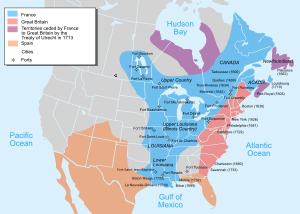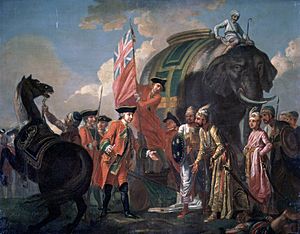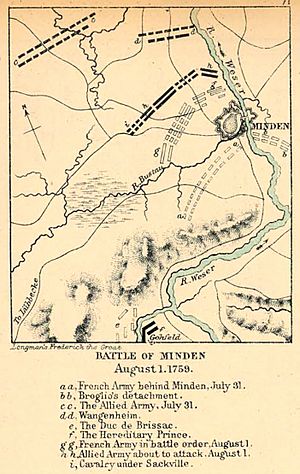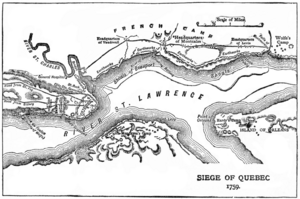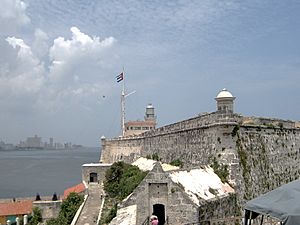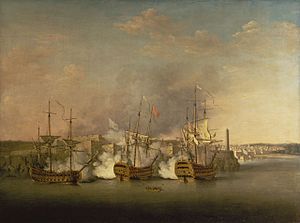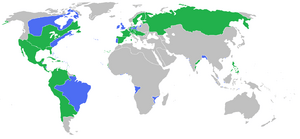Great Britain in the Seven Years' War facts for kids
Great Britain was a main player in the Seven Years' War, which actually lasted nine years, from 1754 to 1763. Britain got involved in 1754 in what was called the French and Indian War in North America. The fighting in Europe, involving countries like Britain and France, started in 1756. That's why it's called the "Seven Years' War."
After the war, Britain became the world's top colonial power. They gained all of New France in North America. This ended France's role as a colonial power there. When Spain joined the war with France in 1762, Britain captured major Spanish ports like Havana, Cuba, and Manila in the Philippines. Britain agreed to give these back in exchange for Spanish Florida. The Treaty of Paris in 1763 officially ended the war. Britain then became the world's strongest naval power.
The war started tough for Britain. They faced losses against France in North America in 1754–55. They also lost Menorca in 1756. That same year, Britain's main ally, Austria, switched sides to join France. Britain quickly formed a new alliance with Frederick the Great's Prussia. For the next seven years, Britain and Prussia fought against many enemies led by France.
After some political trouble, a new government took charge. It was led by the Duke of Newcastle and William Pitt the Elder. This stronger leadership helped Britain achieve its war goals. In 1759, Britain had an amazing year, called an Annus Mirabilis (Wonderful Year). They won against the French in Germany, North America (capturing Quebec), and India.
In 1761, Britain also started fighting Spain. The next year, British forces captured Havana and Manila. These were important cities in the Spanish Empire. They also stopped a Spanish invasion of Portugal. By this time, the Pitt-Newcastle government had ended. Britain was low on money. They accepted the good peace terms offered by France and its allies.
Britain was allied with the Kingdom of Ireland and the Electorate of Hanover. Both were under British military command during the war. Britain also guided the military plans of its colonies worldwide, including British America. In India, the East India Company managed British lands.
Contents
- Why Did the War Start?
- Fighting in North America
- War in Europe (1756–1759)
- War in India (1756–1758)
- The Wonderful Year of 1759
- Conquering Canada (1758–1760)
- British Victory in India (1760–1761)
- War in Europe (1760–1762)
- War with Spain (1762)
- Other Campaigns
- Peace Treaty
- What Happened After the War?
- See also
Why Did the War Start?
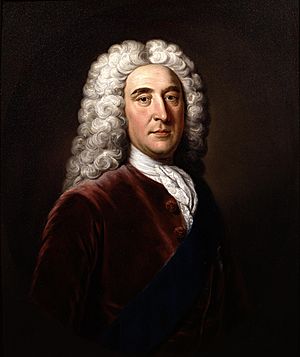
The last big war in Europe, the War of the Austrian Succession, ended in 1748. Many people were not happy with the peace terms. They felt their countries hadn't gained enough. By the early 1750s, another war seemed likely. Austria wanted to take back Silesia from Prussia.
The British Prime Minister, Thomas Pelham-Holles, 1st Duke of Newcastle, became leader in 1754. He had much experience in foreign affairs. Newcastle believed peace was possible if Britain kept its old alliances. This included an alliance with Austria against France.
A big concern for Britain was expanding its colonies. In the 1700s, British colonies in North America grew. They wanted to move west into the Ohio Country. France also claimed this land. It was important for trade and strategy. French control would stop British expansion. It could even surround British colonies. Many colonial leaders asked London to act.
Britain usually avoided sending many troops to Europe. Instead, they allied with European powers who opposed France. Britain would pay these allies to fight. This way, London's money helped their military goals.
During the Seven Years' War, Britain allied with Frederick the Great of Prussia. Prussia was a rising power. Britain paid Prussia a lot of money for its campaigns. This alliance happened in 1756. Austria then allied with France. Unlike France, Britain focused on fighting in the colonies. They used their strong navy. Britain blocked enemy ports and moved troops by sea. They attacked enemy ships and colonies. They often used colonists from nearby British colonies.
Fighting in North America

The Ohio Country was a disputed area between Britain's Thirteen Colonies and France's New France. In 1753, France built forts there. In 1754, Virginia sent George Washington to build a British fort. But a larger French force had already built Fort Duquesne. Washington's small group attacked some French scouts. This led to a fight where a French envoy was killed. The French responded strongly. Washington had to surrender at the Battle of Fort Necessity. The two nations were not officially at war yet.
In 1755, Britain sent troops under General Edward Braddock. They planned to capture French forts. Braddock's force was ambushed by French and Native American fighters near Fort Duquesne. The British were defeated. Braddock died from his wounds. The French kept control of the Ohio Country.
The British did win at Battle of Fort Beauséjour in Acadia. They then forced 12,000 French-speaking Acadians to leave. This was to stop them from helping the French. News of Braddock's defeat angered the British public. William Shirley became the new commander in North America.
More North American Battles (1756–1758)
Britain and France continued to fight with more troops. British colonies had more people than New France. But the French got many Native American allies. These allies raided British frontier areas. Britain sent more soldiers from home.
Britain still struggled in the Ohio Country and Great Lakes. They lost the Battle of Fort Oswego. Then, in 1757, Fort William Henry fell. News of this caused panic. All of New England's local soldiers were called up.
At sea, a British attempt to take Louisbourg in 1757 failed. But in 1758, the Siege of Louisbourg (1758) succeeded. This opened the way to Quebec. After Louisbourg fell, more Acadians were forced to leave.
The war in North America was a stalemate. France held the Ohio territory. But they weren't strong enough to attack the British coastal colonies.
War in Europe (1756–1759)
Britain had been allied with Austria since 1731. But Austria was unhappy with Britain. Austria wanted to get Silesia back from Prussia. When Britain wouldn't help, Austria allied with its old enemy, France. This changed the power balance in Europe.
Britain then made an agreement with Prussia in 1756. This was called the Westminster Convention. Britain hoped this would balance the power. It would stop a big war in Europe. The Dutch Republic, a long-time British ally, stayed neutral.
Loss of Menorca
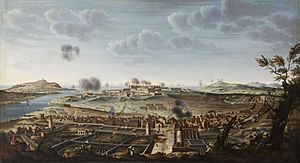
As war in Europe seemed sure, Britain tried to secure Menorca. Admiral John Byng was sent to save it. But a large French fleet and army were already attacking. After a battle, Byng pulled back to Gibraltar. Menorca then fell. Formal war was declared in May 1756.
Byng was called back to Britain and put on trial. People were very angry about losing Menorca. Byng was executed for "not doing his utmost." The government fell. William Pitt then became a key leader.
Alliance with Prussia

The big war in Europe started in August 1756. Frederick the Great of Prussia attacked Saxony and Bohemia. He surprised the Austrians. But an Austrian counter-attack forced the Prussians back.
Britain joined the war on Prussia's side. They sent large amounts of money to Prussia. King George II also supported Prussia. He knew it was vital to defend his German lands in Hanover.
British Troops in Europe
Prussia was attacked from four sides: Austria, France, Russia, and Sweden. Frederick asked London for more help. Britain sent German soldiers to defend Hanover. A small group of British troops joined them. This was rare, as Britain preferred to use its navy.
The French overwhelmed the British and German forces. After a defeat, the Duke of Cumberland signed a deal. Hanover would leave the war. French troops would occupy its land. Prussia and London were shocked. Cumberland was recalled and removed from his command. The deal was cancelled. Hanover re-entered the war.
Ferdinand of Brunswick, Frederick the Great's brother-in-law, took command. He rallied the German troops. He emphasized French cruelty in Hanover. He launched a counter-attack in late 1757. He pushed the French back across the Rhine. The Dutch Republic and Denmark stayed neutral.
New Government Leadership
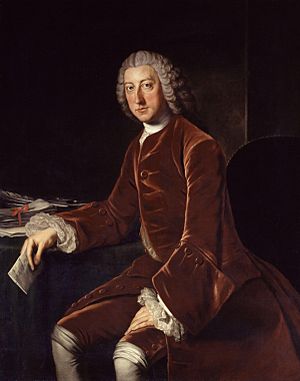
In London, William Pitt's government fell. After a period of no clear leadership, a new partnership formed. The Duke of Newcastle became Prime Minister. He controlled money. William Pitt became Secretary of State. He largely controlled British military plans.
Pitt wanted to focus on attacking French colonies. Newcastle believed the war would be decided in Europe. A compromise was reached. Britain kept troops in Europe under Brunswick. Pitt launched colonial expeditions. He sent forces to West Africa and the West Indies. These attacks were successful and brought money. Patriotism grew in Britain. Pitt, George Anson (navy), and John Ligonier (army) worked together. A law was passed to create a large home defense force. This freed up regular troops for overseas.
Britain's German allies asked for help. They wanted Britain to attack the French coast. This would make France move troops away from the German front. Pitt supported these "descents." A small British force would land, destroy forts and supplies, then leave.
In September 1757, a raid on Rochefort failed. But Pitt kept trying. A raid on Saint-Malo was partly successful. A third raid on Cherbourg in August 1758 was the most successful. Ships and forts were destroyed. However, a later attempt at St Malo ended badly for the British. These raids were costly. Britain then focused its efforts in Europe on Germany.
War in India (1756–1758)
Britain and France had colonies in India. They fought for control. The British East India Company (EIC) had its own troops. The Mughal Empire was weakening. This led to more clashes. Smaller Indian states allied with either Britain or France. Siraj ud-Daulah, the pro-French ruler of Bengal, disliked the British in Calcutta. In 1756, he captured Fort William. Many British prisoners died in the "Black Hole of Calcutta." This became a call for revenge.
Battle of Plassey
A British force from Madras under Robert Clive retook Calcutta. The Third Carnatic War began. Clive contacted Mir Jafar, a chief advisor to the Nawab. He tried to get Mir Jafar to overthrow the Nawab. In February 1757, the British ambushed the Nawab's troops. A truce was agreed.
But neither side was happy. The British feared France would dominate Bengal. Siraj ud-Daulah feared British control. His own people disliked him. On June 23, 1757, the Nawab led 50,000 troops. Clive had a much smaller Anglo-Indian force. Mir Jafar secretly allied with the British. He refused to support the Nawab. The Nawab's army was defeated. Siraj ud-Daulah was overthrown and killed. Mir Jafar became the new Nawab. He made peace with the British.
Mir Jafar later clashed with the British. He tried to get the Dutch East India Company to help him. The Dutch were defeated. Britain replaced Jafar with his son-in-law. In 1765, Britain gained the right to collect taxes in Bengal. This was a very important long-term effect.
The French in India were led by Joseph François Dupleix and Lally. After a British attack, the French were driven out of Bengal. But they still had a strong presence in central India.
The Wonderful Year of 1759
The Annus Mirabilis of 1759 (Latin for 'wonderful year') was a series of big British victories. Before 1759, the war hadn't gone well for Britain. Only in India and North America had Pitt's plans brought gains. Britain learned of a French plan to invade Britain. France was sending troops to Europe, not its colonies. But Britain kept sending its troops to fight for victory in the colonies. Britain was guarded by a large local army.
Britain started 1759 worried about a French invasion. But by the end of the year, they were winning everywhere against France. These victories made people happy. Horace Walpole said, "Our bells are worn threadbare with ringing for victories." Many gave credit to William Pitt the Elder. He guided the military plans. Historians now see the British government as more of a team effort.
Three years later, 1762 was also a great year for Britain. The Anglo-German army stopped a French advance in Germany. The army helped stop a Franco-Spanish invasion of Portugal. They captured Martinique from France. They also captured Havana and Manila from Spain. Some called 1762 a "Second Annus Mirabilis."
Battle of Minden
Since 1758, Britain sent more troops to Germany. Pitt realized this could tie down French troops. Brunswick's army had been very successful. By April 1759, Brunswick had 72,000 soldiers against 100,000 French. The French occupied Frankfurt. Brunswick tried to attack. On April 13, Brunswick lost a battle and had to retreat.
The French slowly chased Brunswick. They captured Minden, which could be used to invade Hanover. Brunswick felt pressured to act. The French also wanted a quick win. On July 31, both sides decided to attack. The French hesitated. The Allies attacked first. One British column advanced too fast. It was attacked by many French forces. The British held them off, but lost many soldiers. When reinforced, the Allies broke through. The French retreated. The British cavalry commander, Sackville, refused to advance. This let the French escape.
Sackville was criticized and sent home. He was replaced by the Marquess of Granby. This victory was crucial. If Brunswick had lost, Hanover would have been invaded. Prussia might have been totally defeated. After the win, the Allies pushed the French back.
French Invasion Plans Fail
France's main plan in 1759 was to invade Britain. Over 50,000 French troops would cross the English Channel and land at Portsmouth. They hoped for a rebellion in Britain. Then they would march on London. Britain knew about the plan. A British raid on Le Havre destroyed many French boats. But the French plans continued.
After naval defeats, France started to doubt the invasion. By autumn, they cancelled it. They didn't have control of the sea. They also couldn't spare enough troops from Europe. The idea of a rebellion in Britain was also too hopeful. This campaign was the last real hope for those who wanted to put the old royal family back on the British throne. After this, France stopped supporting them. Many Scottish Highlanders who had supported the old royal family now fought for Britain.
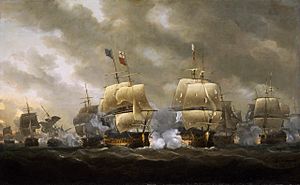
By 1759, the Royal Navy had 71,000 sailors and 275 ships. Britain used a new system of blocking French ports. They kept ships outside French harbors. This made French sailors lose morale.
France needed its fleets to meet in the English Channel for the invasion. But in August 1759, the French Mediterranean Fleet was destroyed near Portugal. Only the Channel Fleet remained. When it tried to break free in November, the British attacked it. This was the Battle of Quiberon Bay. This victory gave Britain almost total control of the seas. The navy also helped in the West Indies, Canada, and India. A small French force did land in Ireland. But it was soon destroyed by the Royal Navy.
Quebec Falls
News of Wolfe's victory at Quebec completed the "Wonderful Year." Quebec was the capital of New France. While 1759 was great for Britain, it was terrible for Prussia. Prussia's armies suffered many defeats. Prussia almost collapsed. It depended on British money. It only survived because the Russian Empress died. Her successor admired Frederick and switched sides.
Conquering Canada (1758–1760)
Louisbourg Captured
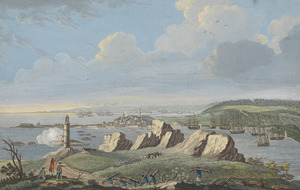
After failing in 1757, Britain tried again to take Louisbourg in 1758. General Jeffery Amherst led the attack. Louisbourg was important for reaching the Saint Lawrence River. After a 44-day siege, the city surrendered. James Wolfe, a young British officer, impressed Pitt. He was promoted to lead future expeditions in Canada. The British waited until spring to go further up the St Lawrence. A naval officer, James Cook, mapped the river. News of the victory made Britain very happy.
Quebec City Taken
Britain's main goal in North America was to take Quebec City. It was the capital of New France. A huge force went up the Saint Lawrence River. Another force marched from New York. France realized the scale of the British attack too late. They couldn't send help to Quebec. The French commander, Louis-Joseph de Montcalm, hoped to hold out for a year.
Wolfe arrived outside Quebec on June 28. He spent the summer looking for a way to attack. Montcalm moved his troops to block him. Wolfe needed to capture the city before winter. An attempt to land at Montmorency failed. On September 12, the British found a good landing spot. Wolfe moved his army there at night. The next day, the Battle of the Plains of Abraham took place. It was a big British victory. Both Wolfe and Montcalm were killed. The British took the city.
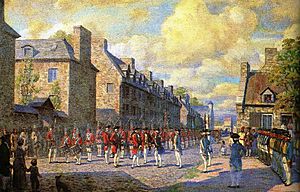
The British also captured Fort Carillon and Fort Niagara. The French and their Native American allies were under pressure. The fighting wasn't over after Quebec. The French still had many forces. The next spring, the French tried to retake Quebec. The Battle of Sainte-Foy was very bloody. The French won, but the British retreated into Quebec. The siege lasted until British ships arrived. This forced the French to retreat.
Montreal Surrenders
British ships and reinforcements ended the French attack. The French retreated towards Montreal. The British followed. They captured parts of Montreal on September 1, 1760. The last French army surrendered on September 6, 1760. A second British army arrived from the south. A French attempt to send more troops was stopped at sea.
Britain had attacked the heart of New France. It was a long and costly campaign. But it was one of Pitt's most successful plans. French military threats in North America ended for good.
British Victory in India (1760–1761)
After the British won at Madras, they attacked. A British force captured the port of Masulipatam. The French commander, Lally, expected more help from his navy. But his admiral was too careful. New British troops arrived. This shifted the balance. The French navy failed to control the Indian Ocean. This left French territory open to capture.
The capture of Pondicherry was a key moment in India. After this, French India was just a few trading posts. The East India Company expanded its control. It created the large territories of British India. By late 1761, the French feared the British would attack Mauritius. They didn't try to get back their losses in India.
War in Europe (1760–1762)
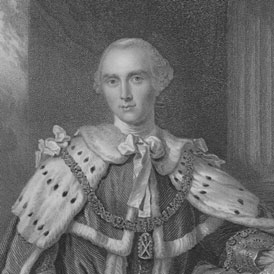
In 1760, King George II died. His grandson, George III, became king. George III cared less about Germany. He also disliked Newcastle and Pitt. He promoted his former teacher, Earl of Bute. Bute wanted peace. He soon disagreed with Pitt. But Bute did agree to Pitt's plan to capture Belle Île in 1761.
West German Campaign
Brunswick continued to lead the Anglo-German army. It received more British resources. Brunswick faced several large French armies. The French still hoped to capture Hanover. This could be used to bargain for peace. The French kept sending many troops, which were needed elsewhere. In 1761, Brunswick won another big victory.
The French made a final attempt to invade Hanover in 1762. They were defeated. Brunswick then attacked. He pushed the French south. He captured Cassel before a ceasefire.
End of the Prussian Alliance
Bute wanted Britain to leave the war in Germany. He suggested to Frederick the Great that he make peace with Austria. Frederick refused. Prussia was in a bad spot in 1761. Debates started in London about stopping all payments to Prussia.
By early 1762, Russian troops were close to Berlin. Prussia was almost divided. But then the Russian Empress died. Her successor, Peter III, admired Frederick. He immediately switched Russia from enemy to ally. This changed the power balance in Europe. Frederick gained the upper hand. He recaptured Silesia. He forced Austria to negotiate.
War with Spain (1762)
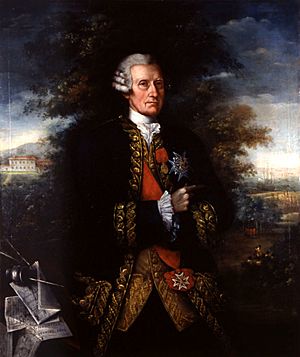
Spain had stayed neutral for most of the war. This was thanks to a pro-British Spanish prime minister. But when Charles III became king, Spain's foreign policy changed. Charles was worried about Britain's conquests. He feared his own empire would be next. He made an alliance with France.
Pitt believed war with Spain was coming. He wanted to attack first. He wanted to capture the annual Spanish silver fleet. This would deny Spain its wealth. The rest of the government refused. Pitt resigned. But war with Spain quickly became unavoidable. On January 4, 1762, Britain declared war on Spain. British ships immediately blocked Cádiz, Spain's main port for silver.
Portugal Invaded
The most urgent issue was a threatened invasion of Portugal. Portugal was a long-time British ally. Spanish forces gathered on the Portuguese border. Britain quickly sent supplies and officers to help Portugal defend itself.
The Spanish plan was to take Almeida and then advance to Lisbon. But they changed their target to Porto. Spanish troops crossed into northern Portugal. But their advance stalled in difficult terrain. British troops arrived that summer. Spain captured the border fortress of Almeida. A British-Portuguese counter-attack captured a Spanish town. French forces arrived to help Spain. But they suffered from disease and desertion. In November, the French and Spanish withdrew and asked for peace. Despite many troops, there were no major battles.
Cuba Captured
In June 1762, British forces from the West Indies attacked Havana, Cuba. They arrived during the fever season. But the British government hoped to surprise the Spanish. The British commander ordered a tunnel dug under the city's fortress walls. British troops got sick quickly. But 4,000 reinforcements arrived from America. On July 30, the mine was blown up. British troops stormed the fortress.
With Havana captured, the British could attack other Spanish targets. But they had lost many soldiers to disease. They focused on securing the area around Havana. During the British occupation, Havana's trade boomed. It was opened to trade with the British Empire. In 1762, the British brought over 10,000 African slaves to Havana.
Philippines Taken
As soon as war was declared with Spain, orders went to British forces in Madras. They were to invade Manila in the Philippines. A force of 10,700 men set off in late July. They arrived in Manila Bay in September 1762. They had to move fast before the monsoon season. On October 6, the British stormed and captured the city. They took a lot of treasure.
Spanish forces regrouped. Rebellions started by the British were stopped. The British couldn't expand their control beyond Manila. British forces also faced desertions. News of Manila's capture reached Europe after the peace treaty. So, its status wasn't decided. The Spanish governor had agreed to pay the British to spare the city. But the full amount was never paid. The British occupied Manila for 20 months, ending in 1764.
Other Campaigns
Senegal
Pitt had an early plan for West Africa. France had profitable but not very important bases there. Pitt faced doubts from the British government. They saw Europe as the main place to fight. Pitt got support for an expedition to take the French trading post at Fort Louis. They took it easily. They brought back much treasure. Later, other French posts were also captured.
Martinique

Britain failed to take Martinique in 1759. But in 1761, a new plan was made. Martinique was successfully captured by a British force in February 1762. This was followed by the capture of Saint Lucia, Grenada, and Saint Vincent. Many local planters welcomed the British. It ended Britain's naval blockade. It also restored their access to international trade.
Newfoundland
In a final attempt, the French sent an expedition to Newfoundland. It was valuable for its fishing. The small British garrison was swiftly defeated. The French hoped to use Newfoundland as a bargaining chip. General Amherst sent troops from New York. His brother, William Amherst, led them. They defeated a French force at the Battle of Signal Hill on September 15, 1762. The French surrendered three days later.
Peace Treaty
By 1763, the British government was very short on money. But France's money problems were worse. The alliance with Prussia ended. By late 1762, the war was ending worldwide. In Britain, the new Bute government took control. They agreed to a ceasefire. New peace talks began in Paris.
The peace talks were very controversial in Britain. Newcastle and Pitt strongly opposed the terms. They felt the terms were too easy on France and Spain. Some people even attacked King George III's carriage in protest. But Bute felt the war had to end. He thought the terms were fair.
Britain was in a strong position. They had taken Canada, Guadeloupe, Martinique, Pondicherry, Senegal, and Belle Île from France. They also took Havana and Manila from Spain. Only one British territory, Menorca, was in enemy hands. Spain wanted to keep fighting. But France did not. Bute suggested that France give its remaining North American land to Spain. This would make up for Spain's losses. This idea worked for Spain. It gave Britain and France more room to negotiate.
Terms of the Peace Agreement
Britain made a separate peace with France and Spain. Britain gained formal control of New France. They gave back Martinique and Guadeloupe. The British got all of mainland North America east of the Mississippi River.
Sir George Macartney noted that Britain now controlled "a vast Empire, on which the sun never sets." France was happy they didn't lose more land in the Caribbean. They were also glad to keep a presence in Newfoundland. This ensured access to valuable fishing. A separate peace treaty between Austria and Prussia was signed. It returned Central Europe to how it was before the war.
What Happened After the War?
The British forces had relatively few deaths. But over a million people died worldwide. France and Spain saw the peace treaty as a temporary break. William Pitt called it an "armed truce." Britain usually cut its military size in peacetime. But in the 1760s, a large military was kept. This was to deter France and Spain. Both France and Spain sent spies to check Britain's defenses. They believed invading Britain was key to any revenge war.
The British victory also led to the American War of Independence. American colonists were happy about the new lands. But many were angered by the Proclamation of 1763. This tried to protect Native American land. It prevented European settlement. Also, British troops staying in private homes became a problem. These events caused a rift between the British government and its American colonies.
The war also ended the "Old System" of alliances in Europe. After the war, Britain tried to rebuild these alliances. But European states like Austria and the Dutch Republic saw Britain as a bigger threat than France. They didn't join Britain. Prussia was angry about what it saw as a British betrayal in 1762. So, when the American War of Independence became a global war, Britain faced many European powers alone. They had no major allies.
See also
|



